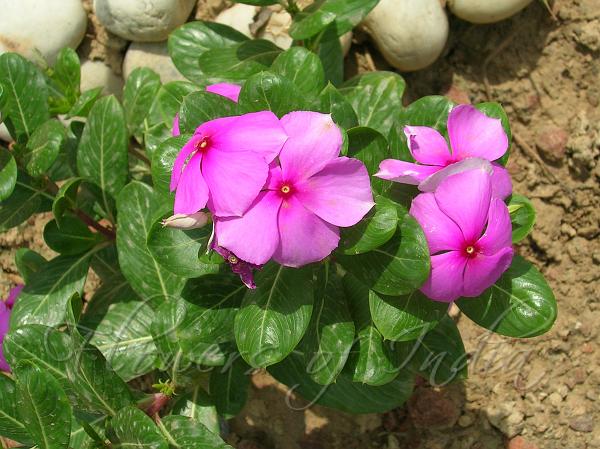|
| Periwinkle |
|

|

| File size | 670812 |
| Original date | 5/21/06 1:42 PM |
| Resolution | 2048 x 1536 |
| Flash | Flash did not fire, auto |
| Focal length | 8.0mm |
| Exposure time | 1/476s |
| Aperture | 5.5 |
| Focus Distance | |
| Metering Mode | Partial |
| Camera make | NIKON |
| Camera model | E3700 |
| Sensor type |
|
|
|
Photo: |
Botanical name: Catharanthus roseus Family: Apocynaceae (Oleander family)
Synonyms: Vinca rosea, Pervinca rosea
Synonyms: Vinca rosea, Pervinca rosea
Periwinkle is a happy-go-lucky small subshrub. It grows in adverse conditions,
rain, heat, dust. It can be quite often seen growing out of cervices of walls.
It is an evergreen subshrub or herbaceous plant growing 1 m tall. The
leaves are oval to oblong, 2.5–9 cm long and 1–3.5 cm broad, glossy
green, hairless, with a pale midrib and a short leaf-stalk 1–1.8 cm
long; they are arranged in opposite pairs. The flowers are white to dark
pink with a darker red centre, with a basal tube 2.5–3 cm long and
a flower 2–5 cm diameter with five petal-like lobes. The fruit is a
pair of follicles 2–4 cm long and 3 mm broad. Lots of cultivars have
been developed with various colors, from red to white.
Medicinal uses: In Ayurveda the extracts of its roots and shoots,
though poisonous, is used against several diseases. In traditional
Chinese medicine, extracts from it have been used against numerous
diseases, including diabetes, malaria, and Hodgkin's lymphoma. Many
of the vinca alkaloids were first isolated from Catharanthus roseus. The
substances vinblastine and vincristine extracted from the plant are used
in the treatment of leukemia and Hodgkin's lymphoma.
In Ayurveda the extracts of its roots and shoots,
though poisonous, is used against several diseases. In traditional
Chinese medicine, extracts from it have been used against numerous
diseases, including diabetes, malaria, and Hodgkin's lymphoma. Many
of the vinca alkaloids were first isolated from Catharanthus roseus. The
substances vinblastine and vincristine extracted from the plant are used
in the treatment of leukemia and Hodgkin's lymphoma.
Medicinal uses:
 In Ayurveda the extracts of its roots and shoots,
though poisonous, is used against several diseases. In traditional
Chinese medicine, extracts from it have been used against numerous
diseases, including diabetes, malaria, and Hodgkin's lymphoma. Many
of the vinca alkaloids were first isolated from Catharanthus roseus. The
substances vinblastine and vincristine extracted from the plant are used
in the treatment of leukemia and Hodgkin's lymphoma.
In Ayurveda the extracts of its roots and shoots,
though poisonous, is used against several diseases. In traditional
Chinese medicine, extracts from it have been used against numerous
diseases, including diabetes, malaria, and Hodgkin's lymphoma. Many
of the vinca alkaloids were first isolated from Catharanthus roseus. The
substances vinblastine and vincristine extracted from the plant are used
in the treatment of leukemia and Hodgkin's lymphoma.| Identification credit: Tabish | Photographed in Delhi. |
• Is this flower misidentified? If yes,